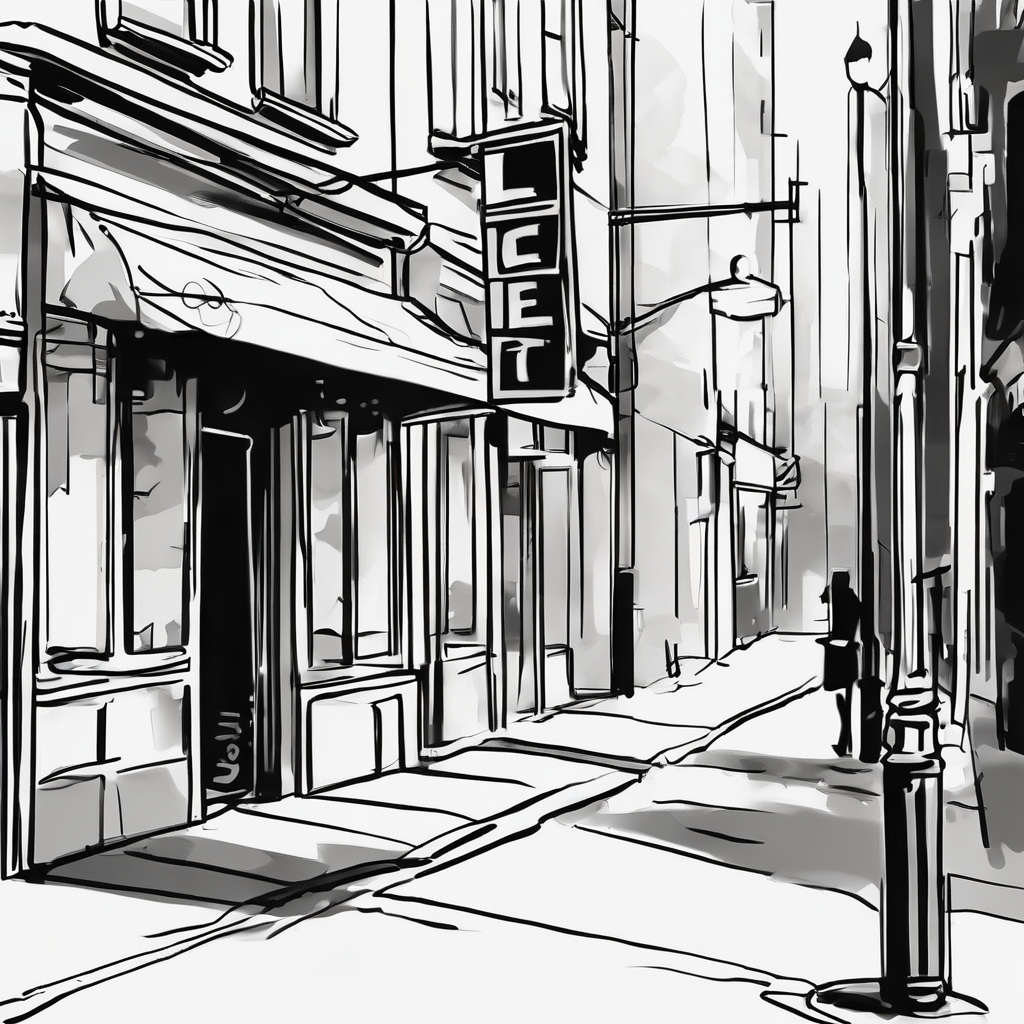Have you ever found yourself sketching random shapes during a boring meeting or class? Congratulations—you’re already a doodler! Those little drawings aren’t just mindless scribbles; they’re your brain’s creative way of staying engaged. Easy doodle patterns for beginners transform those random marks into intentional, beautiful designs that anyone can create, regardless of artistic ability. Whether you’re looking to add personality to your notes, find a relaxing hobby, or simply explore your creative side, doodling offers an accessible entry point into the world of art.
Key Points Summary:
- Doodling requires minimal supplies and no artistic experience
- Basic shapes form the foundation of all doodle patterns
- Regular doodling improves focus, memory, and reduces stress
- Simple patterns can be combined to create complex, beautiful designs
- Doodles have practical applications in journaling, note-taking, and gift-making
What Makes Doodling Different from Drawing?
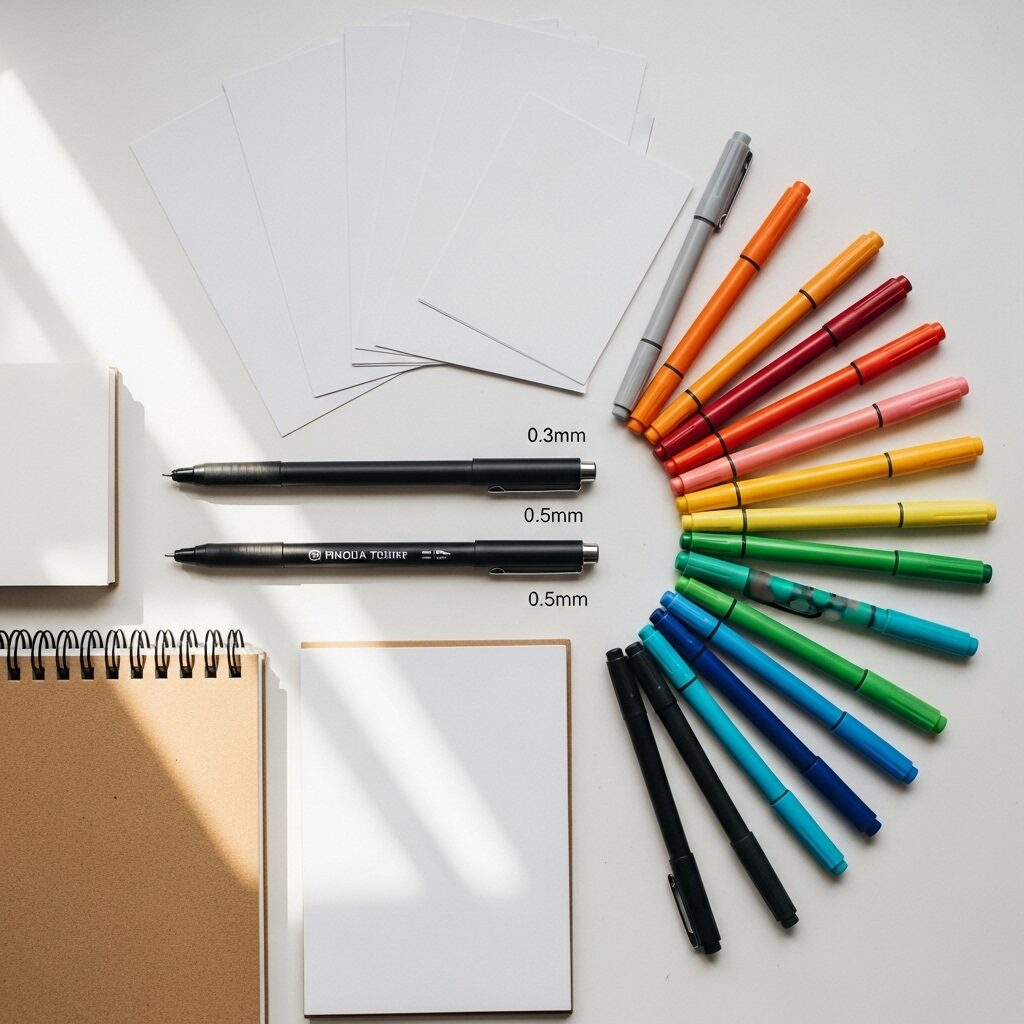
Let’s clear up a common misconception: doodling isn’t “bad drawing.” It’s actually a distinct creative practice with its own rules—or rather, lack of rules. While traditional drawing techniques often require planning, proper proportions, and specific skills, doodling celebrates spontaneity and imperfection.
Think of doodling as visual thinking. It’s what happens when your hand moves freely across the page, creating patterns, shapes, and designs without overthinking the outcome. The beauty of doodling lies in its accessibility—there’s no pressure to create a masterpiece, no need for expensive materials, and absolutely no requirement for previous experience.
“Doodling is not just a distraction; it’s a tool for maintaining cognitive focus and enhancing creative thinking.”
Gabriela Goldschmidt, Design Researcher
The Surprising Brain Benefits of Simple Doodles
Before we dive into patterns, let’s talk about why doodling deserves a place in your daily routine. Research shows that doodling activates multiple brain regions simultaneously, making it more than just a fun pastime.
Cognitive and Emotional Benefits:
| Benefit | How It Helps |
|---|---|
| Improved Focus | Keeps your brain active during passive activities like listening to lectures |
| Better Memory | Visual patterns help encode and recall information more effectively |
| Stress Reduction | Repetitive motions create a meditative, calming effect |
| Enhanced Creativity | Freeform expression opens neural pathways for innovative thinking |
| Problem Solving | Visual exploration helps work through complex ideas |
According to a study published by Applied Cognitive Psychology, participants who doodled while listening to a dull phone message recalled 29% more information than non-doodlers. That’s a significant boost for students or anyone who needs to retain information!
Getting Started: Your Doodling Toolkit
One of the best parts about learning easy doodle patterns for beginners? You probably already own everything you need. Unlike watercolor painting or other art forms that require specialized materials, doodling thrives on simplicity.
Essential Supplies:
- Any pen or pencil (seriously, whatever’s within reach works)
- Paper of any kind—notebook, printer paper, or even napkins
Optional Additions:
- Fine-tip pens in various sizes (0.3mm, 0.5mm, 0.7mm) for detail work
- Colored pens or markers for adding visual interest
- A pencil for light guide lines you can erase later
- A small sketchbook dedicated to your doodle practice
The key is removing barriers to entry. Don’t wait for the “perfect” supplies—grab what you have and start creating today.
Building Blocks: The Basic Shapes Behind Every Doodle
Here’s a secret that transforms beginners into confident doodlers: every complex pattern breaks down into simple shapes. Master these foundational elements, and you’ll unlock countless design possibilities.
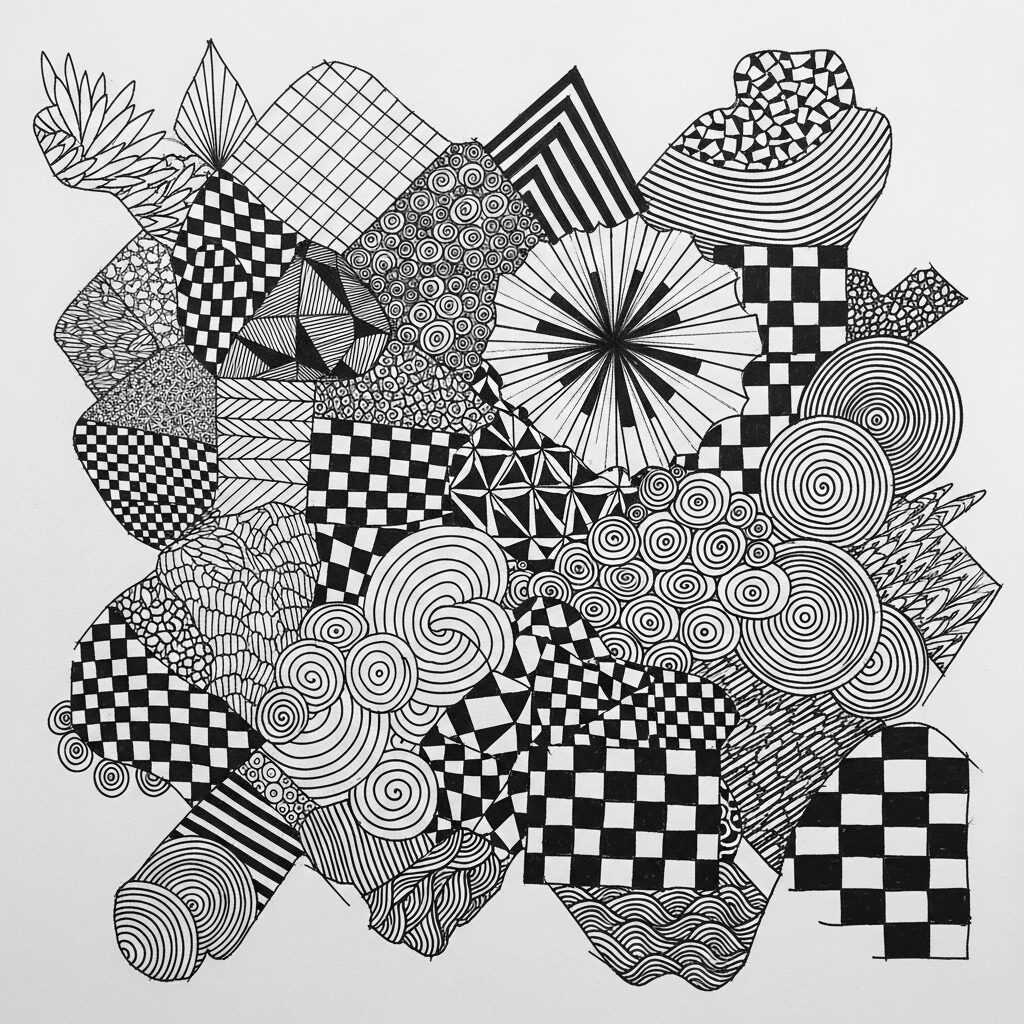
The Five Essential Shapes:
- Circles and ovals – Perfect for flowers, bubbles, and decorative fills
- Straight lines – Create grids, borders, and geometric patterns
- Curves and waves – Add organic, flowing movement to designs
- Triangles – Build mountains, arrows, and geometric interest
- Dots – Essential for stippling, starbursts, and texture
Practice drawing each shape repeatedly. Fill a page with circles of different sizes. Draw waves that ripple across your paper. Create triangles pointing in various directions. This warm-up exercise trains your hand muscles and builds confidence before tackling patterns.
Easy Doodle Patterns to Try Right Now
Now for the fun part—actual patterns you can create today! These easy doodle patterns for beginners progress from simple to slightly more complex, but all remain accessible to complete novices.
Geometric Patterns: Clean Lines and Satisfying Repetition
Geometric doodles use structure and repetition to create visually pleasing designs. They’re perfect for creating borders or filling spaces in your bullet journal.
Pattern Ideas:
- Grid patterns: Draw parallel horizontal lines, then add vertical lines to create squares. Fill alternating squares with different designs
- Zigzags: Create mountain-like patterns by connecting diagonal lines in alternating directions
- Concentric shapes: Draw a circle, then another larger circle around it, and another, creating a target-like effect
- Checkerboards: Make a simple grid and fill alternating squares with solid black
- Parallel lines: Draw sets of three or four lines together, leaving white space between groups
Abstract and Organic Patterns: Let Your Hand Flow
Abstract doodles embrace freeform creativity. These patterns don’t represent real objects—they’re pure visual expression.
Pattern Ideas:
- Swirls and spirals: Start at a center point and curve outward in expanding circles
- Waves: Draw flowing S-curves that overlap and intersect
- Bubbles: Create various-sized circles that touch and overlap, like soap bubbles
- Scales: Draw repeated semicircles in rows, each touching the one before
- Pebbles: Fill space with organic, rounded shapes of different sizes
- Interconnected lines: Draw wandering lines that occasionally touch and cross
Nature-Inspired Doodles: Bring the Outdoors to Your Page
Nature provides endless inspiration for simple patterns. These designs work beautifully for decorating notes or creating themed pages.
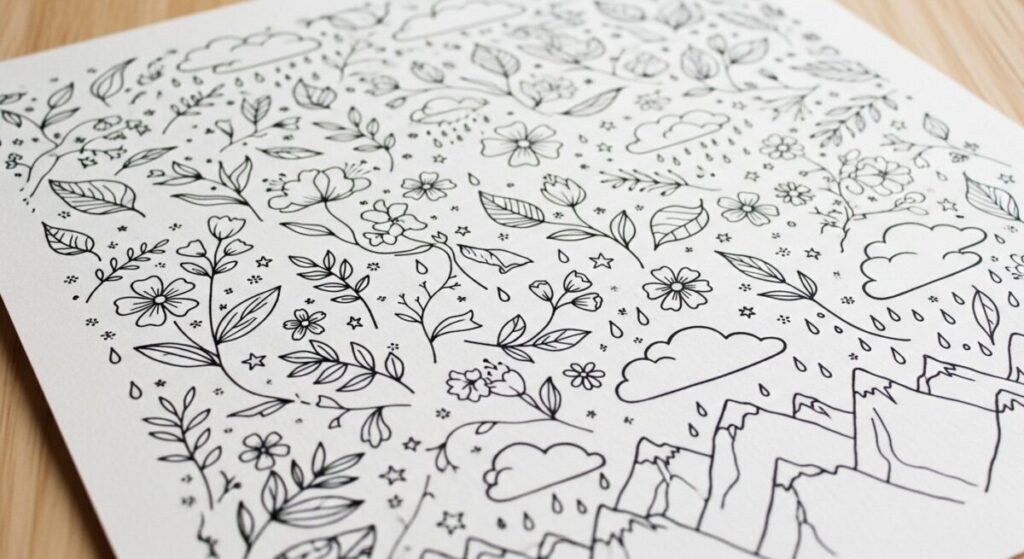
Simple Nature Patterns:
- Leaves: Draw simple oval shapes with a center vein line
- Basic flowers: Create a circle center with rounded petals around it
- Stars: Draw two overlapping triangles (one upside down)
- Clouds: Use connected bumpy curves to form fluffy shapes
- Mountains: Create triangular peaks in various sizes
- Raindrops: Draw teardrop shapes scattered across your page
- Vines: Draw curving lines with small leaves branching off
Check out this helpful video tutorial for drawing simple nature doodles:
Cute Everyday Objects: Doodle Your Daily Life
Simplifying familiar objects into doodles makes them instantly recognizable and charming.
Easy Object Doodles:
- Hearts: The classic symbol everyone knows how to draw
- Coffee cups: Draw a rectangle with a handle and wavy “steam” lines
- Ice cream cones: Triangle base topped with circular scoops
- Books: Simple rectangles stacked or standing upright
- Fruits: Circles with tiny details (apple stem, grape cluster)
- Candles: Vertical rectangles topped with teardrop flames
Simple Animal Silhouettes: Creatures in Basic Shapes
You don’t need to be a wildlife illustrator to doodle animals. Break them into basic shapes for adorable results.
Beginner-Friendly Animals:
- Cats: Circle head, triangle ears, simple body shape
- Birds: Teardrop body, triangle beak, simple wings
- Butterflies: Draw a line, add rounded wings on each side
- Whales: Large curved shape with a tail fin
- Octopuses: Circle with wavy tentacles hanging down
Similar to cartoon drawing, simplification is key to successful animal doodles.
Creating Decorative Borders and Space Fillers
One practical application of easy doodle patterns for beginners is creating borders for journal pages, notes, or cards. Borders frame your content and add visual interest.
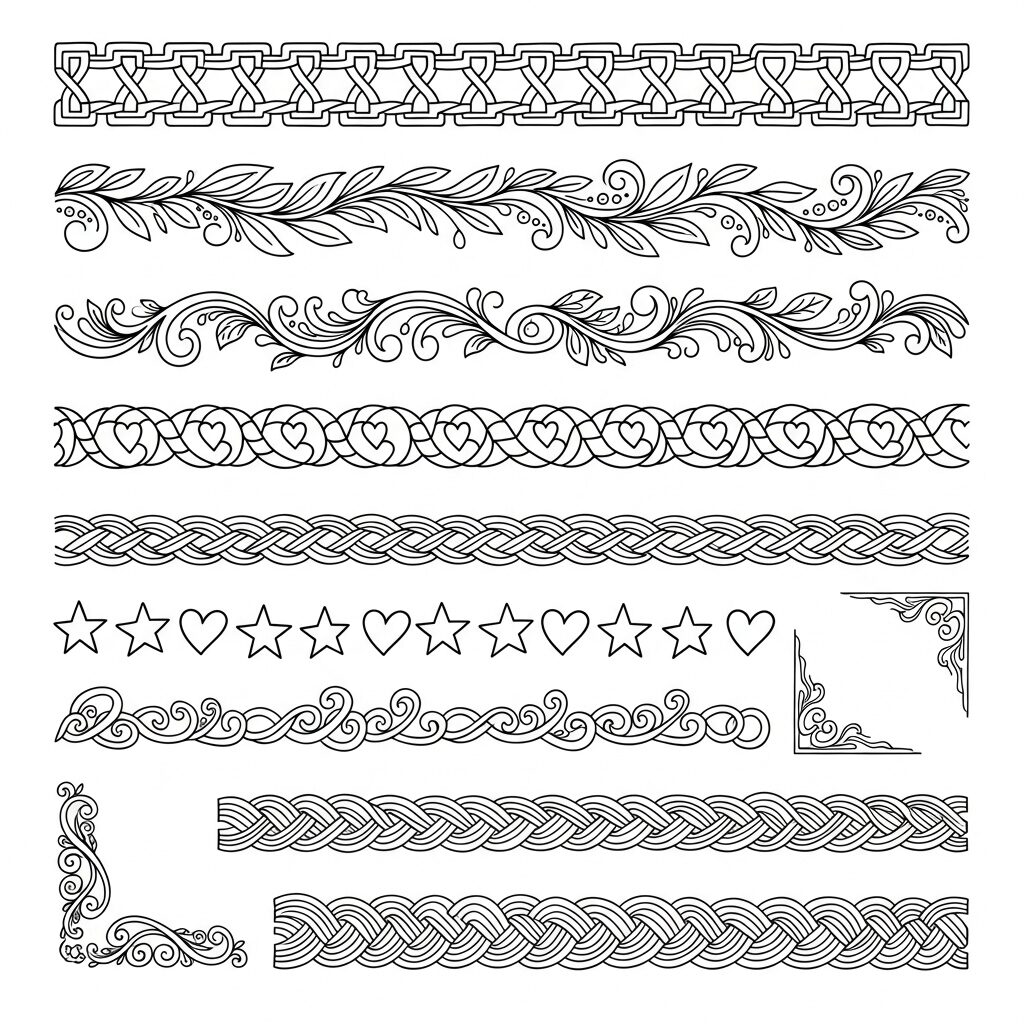
Border Ideas:
- Repeated shapes (circles, triangles, hearts) in a line
- Vine patterns that weave along the page edge
- Geometric patterns like zigzags or waves
- Alternating patterns (circle, star, circle, star)
- Simple braided or rope designs
Space Fillers help complete a design when you have awkward empty areas:
- Dots scattered in varying densities
- Small stars sprinkled throughout
- Tiny hearts or flowers
- Short lines radiating like sunshine
- Small spirals or swirls
Essential Tips for Your Doodling Journey
As you explore easy doodle patterns for beginners, keep these practical tips in mind to enhance your experience and accelerate your progress.
Start Small and Build Gradually Don’t feel pressured to fill entire pages immediately. Begin with small sections—a corner of your notebook, a margin, or a sticky note. Small victories build confidence.
Embrace Consistency Over Perfection Daily practice matters more than marathon sessions. Doodle for five minutes each day rather than an hour once a week. This regularity trains your hand and develops muscle memory.
Develop Your Unique Style Your “wobbly” lines aren’t mistakes—they’re your signature style. Two people following the same pattern tutorial will create different results, and that’s the magic of doodling. Embrace what makes your doodles distinctly yours.
Use Pencil Guidelines When Needed For more complex patterns, lightly sketch guidelines in pencil first. Once you’re happy with the design, trace over it in pen and erase the pencil marks. This approach reduces anxiety about making permanent mistakes.
Find Inspiration Everywhere Look at fabric patterns, tile designs, zentangle patterns, nature photos, and architecture. Notice how patterns repeat, intersect, and create visual interest. Keep a small notebook to quickly sketch patterns you encounter in daily life.
Learn Through Copying (Respectfully) When starting out, copying patterns from tutorials helps you understand how they’re constructed. This is perfectly acceptable for personal learning. If you share copied work online, always credit your inspiration source.
Practical Applications: Where to Use Your Doodles
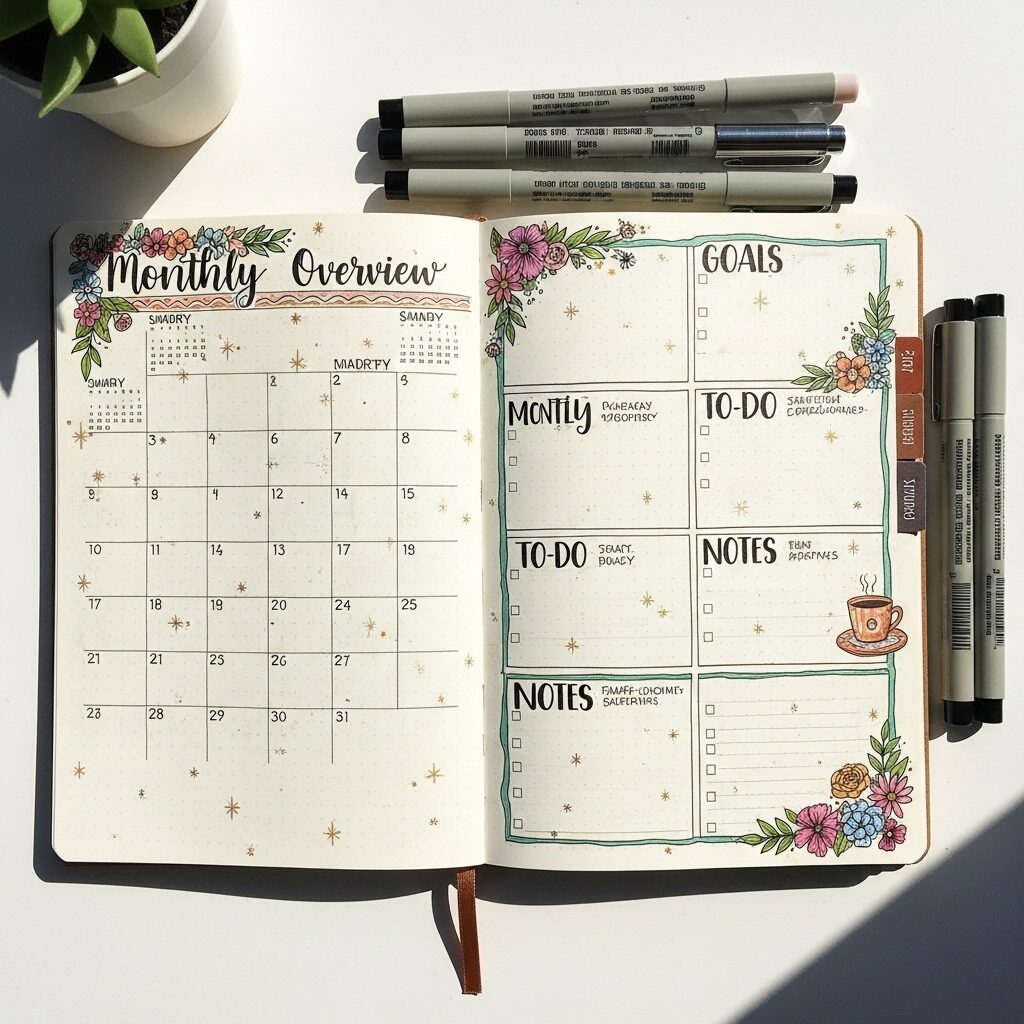
Bullet Journals and Planners Doodles transform functional planning tools into personalized art pieces. Add borders to monthly spreads, create decorative section headers, or fill blank spaces with thematic patterns.
Study Notes and Notebooks Research shows that doodling during lectures improves information retention. Add relevant visual patterns to your notes—science notes could feature molecular-looking geometric patterns, while history notes might include period-appropriate decorative borders.
Greeting Cards and Gifts Hand-doodled cards show thoughtfulness that store-bought versions can’t match. Create simple patterns around birthday messages or holiday greetings. Even wrapping paper becomes special with custom doodles.
Mindful Breaks and Stress Relief Keep a doodle page open during stressful periods. When anxiety rises or concentration wanes, spend a few minutes adding to your pattern. The repetitive nature of doodling activates the same relaxation response as meditation.
Frequently Asked Questions About Easy Doodle Patterns
How do I start doodling as a beginner? Start by practicing basic shapes like circles, lines, and curves. Then choose one simple pattern from this guide—perhaps swirls or basic flowers—and fill a small space with that pattern. Don’t overthink it; just let your hand move naturally. Remember, there’s no wrong way to doodle.
What are some easy doodle patterns to try? The easiest patterns for absolute beginners include dots arranged in groups, simple swirls, zigzag lines, basic flowers (circle center with petals around it), stars, and hearts. Geometric patterns like grids and checkerboards also work well because they follow predictable structures.
What are the benefits of doodling? Doodling offers numerous benefits including improved focus and memory retention (up to 29% better recall), reduced stress and anxiety, enhanced creativity, better problem-solving abilities, and a relaxing mindfulness practice. It’s essentially meditation with a pen.
Can anyone doodle, even if they can’t draw? Absolutely! Doodling doesn’t require traditional drawing skills. If you can write your name, you can doodle—it uses the same basic hand movements. Doodling focuses on patterns and repetition rather than realistic representation, making it accessible to everyone regardless of artistic background.
What basic supplies do I need for doodling? You only need two things: something to write with (any pen, pencil, or marker) and something to write on (any paper—notebook, printer paper, even napkins work). That’s it! While specialty pens and nice sketchbooks can enhance the experience, they’re completely optional for beginners.
Your Creative Journey Starts Now
Learning easy doodle patterns for beginners isn’t about becoming a professional artist—it’s about discovering a joyful, accessible creative practice that enriches your daily life. Every expert doodler started exactly where you are now, with a pen, some paper, and curiosity. The patterns you create today might seem simple, but they’re building blocks for increasingly complex designs as your confidence grows. More importantly, they’re providing proven cognitive benefits while offering a peaceful escape from digital distractions. So grab whatever pen is nearby, turn to any blank page, and start with a simple circle. Then add another. And another. Before you know it, you’ll have created your first doodle pattern—and discovered why millions of people worldwide have fallen in love with this meditative, creative practice.
Additional Resources
- The Doodle Revolution – Sunni Brown TED Talk – Explores the cognitive benefits of doodling
- Zentangle Official Method – Structured approach to pattern drawing
- Applied Cognitive Psychology Study on Doodling – Research on doodling and memory retention
- Bullet Journal Community – Practical applications for doodles


